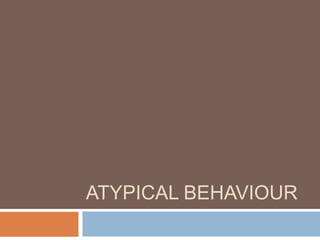
Atypical Behaviour - Definitons
- 3. What behaviours are „atypical‟? List as many examples of behaviour as you can think of which are “atypical” or “abnormal” and “normal” What level of agreement is there in the class about these?
- 4. Atypical Behaviour A psychological condition or behaviour that departs from the norm or is harmful and distressing for the individual or those around them. These types of behaviours usually violate what society feels is appropriate. Defining what is atypical is a judgement. How did we deal with „abnormal‟ behaviour in the past?
- 5. Definition 1:Statistical Infrequency Statistics can be used to find out the norm of a society. You can use these statistics to categorise people into frequent/normal/typical or atypical. How Atypical are you?
- 6. Normal Distribution When measuring most aspects of human behaviour you would get a normal distribution – bell shaped curve. Most people („the normals‟) would be in the middle (the mean) , fewer people (the „atypicals‟) would be at either extreme.
- 7. Cultural Relativism What is deemed to be „atypical‟ in our society may be considered normal in others (and vice versa!). This can also change over time. Even within a society these norms can be different - Subcultural Theory. Can you think of any behaviours that are culturally specific?
- 8. Definition 2: Deviation from social norms Atypical behaviour is defined here by behaviour which is not statistically deviant but socially deviant. These behaviours go against our social norms – they are considered to be anti-social or undesirable. It considers a behaviour as atypical if the majority considers it unacceptable or undesirable. In this way it appears to overcome the „desirability‟ criticism of the statistical infrequency approach. result in labelling people as mentally Often can ill if they don't go along with the prevailing This allows us to understand whysystem political atypical
- 9. Thomas Szasz (1960) "If you talk to God, you are praying; If God talks to you, you have schizophrenia. If the dead talk to you, you are a spiritualist; If you talk to the dead, you are a schizophrenic.“ While people behave and think in ways that are very disturbing, this does not mean they actually have a disease.
- 10. DEFINITON 3: FAILURE TO FUNCTION ADEQUATELY A person is considered abnormal if they are unable to cope with the demands of everyday life. They may be unable to perform the behaviours necessary for day-to-day living e.g. self-care, hold down a job, interact with others, make themselves understood etc. Rosenhan and Seligman (1989) 7 features associated with atypical behaviour. Individually they may not be enough to cause a problem but when several are present then they are symptomatic of abnormality. Suffering (personal distress), Maladaptiveness (destructive behaviour), Unconventional behaviour, Unpredictability, Irrationality, Observer discomfort and Violation of moral and ideal standards.
- 11. DEFINITION 4: DEVIATION FROM IDEAL MENTAL HEALTH Rather than defining what is abnormal, we define what is normal and anything that deviates from this is regarded as abnormal. Psychologists vary, but usual characteristics include: 1. Positive view of self 2. Personal growth and development 3. Autonomy/Self-actualisation (able to act independently, make own decisions and find satisfaction within themselves) 4. Accurate view of reality 5. Positive relationships 6. Environmental mastery (effectively meeting the demands of situations and being flexible to adapt to change)